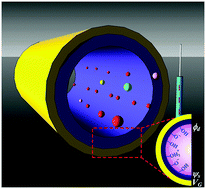Gate modulation of proton transport in a nanopore†
Abstract
Proton transport in confined spaces plays a crucial role in many biological processes as well as in modern technological applications, such as fuel cells. To achieve active control of proton conductance, we investigate for the first time the gate modulation of proton transport in a pH-regulated nanopore by a multi-ion model. The model takes into account surface protonation/deprotonation reactions, surface curvature, electroosmotic flow, Stern layer, and electric double layer overlap. The proposed model is validated by good agreement with the existing experimental data on nanopore conductance with and without a gate voltage. The results show that the modulation of proton transport in a nanopore depends on the concentration of the background salt and solution pH. Without background salt, the gated nanopore exhibits an interesting ambipolar conductance behavior when pH is close to the isoelectric point of the dielectric pore material, and the net ionic and proton conductance can be actively regulated with a gate voltage as low as 1 V. The higher the background salt concentration, the lower is the performance of the gate control on the proton transport.


 Please wait while we load your content...
Please wait while we load your content...